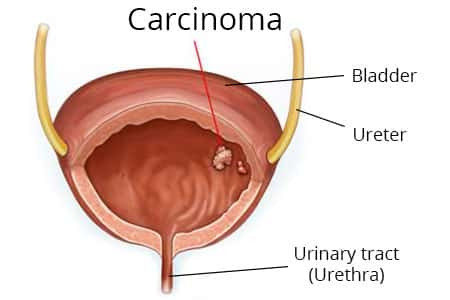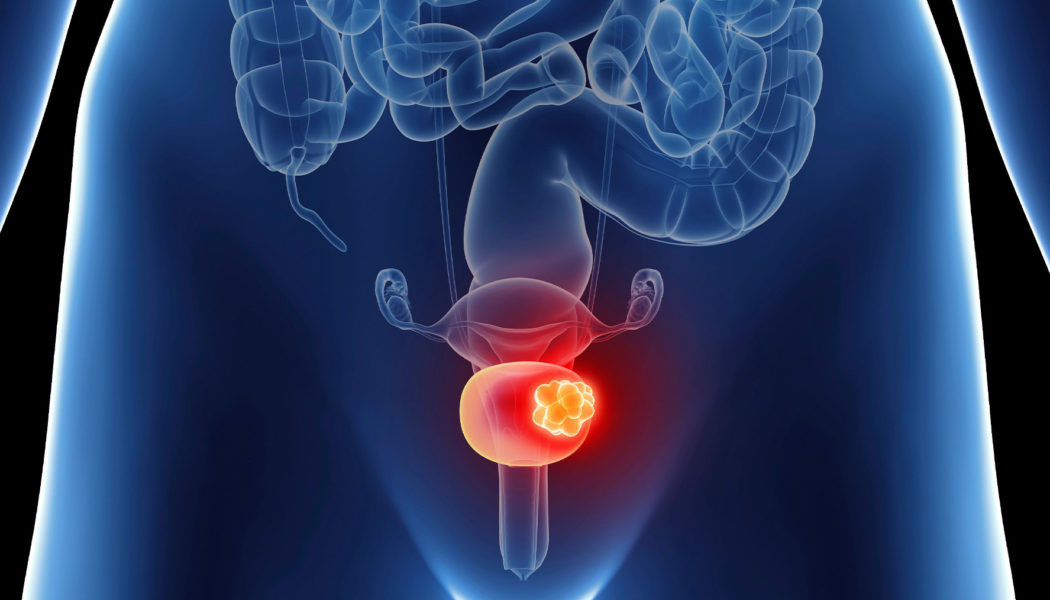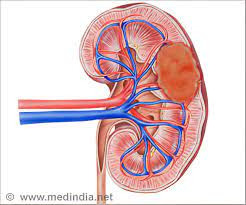Definisi
Karsinoma urotelial adalah kanker yang dapat terjadi di kandung kemih, saluran uretra, saluran ureter, dan sebagian ginjal. Kanker ini termasuk salah satu jenis kanker saluran kemih yang paling sering ditemui. Kondisi ini disebabkan kelainan pada sel yang melapisi dinding bagian dalam saluran kemih.
Di beberapa negara berkembang, karsinoma urotelial merupakan tumor ke-6 yang paling sering terjadi. Lokasi karsinoma urotelial paling sering adalah di bagian bawah atau di kandung kemih kira-kira sebanyak 90-95% kasus. Sementara sisanya terjadi di saluran kemih bagian atas.
Karsinoma urotelial dapat ditangani dengan beberapa cara, tapi angka kekambuhannya cukup tinggi tergantung stadium penyakit saat didiagnosis dan penanganan yang sudah dilakukan.
Penyebab
Penyebab dari karsinoma urotelial adalah perubahan DNA atau mutasi DNA pada sel yang melapisi dinding bagian dalam saluran kemih. Karsinoma urotelial lebih banyak menjadi penyebab kanker kandung kemih.
Karsinoma ini dapat mengenai bagian saluran kemih lain karena lapisan dinding bagian dalam merupakan sel yang sama. Perubahan DNA ini masih belum diketahui dengan pasti penyebabnya. Namun ada beberapa faktor risiko yang dapat meningkatkan angka kejadian karsinoma urotelial ini.
Sel memiliki DNA di dalamnya yang berisi instruksi untuk sel tersebut bekerja dan hidup. Normalnya, sel memiliki siklus hidup dengan batas waktu tertentu dan tidak bekerja di luar kendali. DNA yang sudah bermutasi pada sel akan menyebabkan perubahan perilaku sel menjadi lebih agresif.
Perubahan yang terjadi, seperti tumbuh berlebihan dalam waktu yang cepat, tidak memiliki siklus hidup atau tidak mati seperti sel normal, bahkan menyerang sel atau jaringan normal di dalam tubuh. Sel-sel ini akan berkembang dan membentuk tumor yang menyerang jaringan normal di sekitarnya. Pada satu titik, sel yang abnormal ini dapat menyebar lebih jauh ke seluruh tubuh (metastasis).
Karsinoma urotelial adalah jenis karsinoma paling sering pada kanker kandung kemih. Sebelumnya disebut sebagai karsinoma sel transisional karena sel jenis ini yang berada dan melapisi dinding dalam pada hampir semua bagian saluran kemih. Sel urotelial ini memiliki sifat yang fleksibel di dalam kandung kemih. Sel urotelial akan mengembang ketika kandung kemih penuh dan akan menyusut ketika kandung kemih kosong.
Faktor Risiko
Faktor risiko karsinoma urotelial bervariasi. Banyak faktor risiko yang berasal dari lingkungan dan menyebabkan perkembangan karsinoma urotelial. Beberapa diantaranya adalah :
- Rokok. Perokok aktif ataupun pasif memiliki risiko tinggi mengalami karsinoma urotelial karena paparan zat berbahaya
- Riwayat kanker kandung kemih di keluarga
- Konsumsi air yang mengandung arsenik (bahan yang digunakan sebagai pestisida/insektisida)
- Konsumsi alkohol
- Riwayat kanker kandung kemih sebelumnya
- Paparan zat kimia berbahaya di tempat kerja. Contoh industri yang berisiko seperti industri karet, tekstil, cat, dan kulit
- Riwayat terapi radiasi
Gejala
Gejala karsinoma urotelial tergantung lokasi kanker ini berada. Karena lebih sering berada di kandung kemih, gejala karsinoma urotelial mirip dengan kanker kandung kemih. Beberapa diantaranya adalah :
- Hematuria atau perdaranhan di urine. Warna urine berubah menjadi merah muda, merah, atau seperti teh. Adanya perdarahan pada urine dapat tidak terlihat dengan kasat mata dan baru ditemukan pada pemeriksaan di bawah mikroskop
- Nyeri pinggang belakang. Biasanya disebabkan pertumbuhan jaringan tumor yang menyebabkan sumbatan
- Masalah buang air kecil. Seperti nyeri saat berkemih, tidak dapat menahan buang air kecil, dan frekuensi buang air kecil meningkat
- Nafsu makan berkurang
- Penurunan berat badan
- Kelelahan
- Demam yang tidak jelas penyebabnya
- Keringat dingin terutama di malam hari
Diagnosis
Diagnosis karsinoma urotelial dilakukan dengan wawancara gejala oleh dokter. Kemudian dilanjutkan pemeriksaan fisik dan pemeriksaan penunjang. Beberapa pemeriksaan penunjang yang dilakukan adalah :
- Urinalisis
- Pemeriksaan dilakukan dengan menampung urine dan memeriksa urine di laboratorium. Berguna untuk melihat adanya darah di urine atau komponen mencurigakan lain
- CT urografi
- Pemeriksaan ini memiliki tingkat akurasi tinggi untuk menegakkan diagnosis
- MRI urografi
- Dilakukan apabila pemeriksaan CT urografi tidak dapat dilakukan
- Sistoskopi
- Pemeriksaan dengan memasukkan selang kecil berkamera dan berlampu ke dalam kandung kemih
- Sitologi
- Pemeriksaan dilakukan dengan mengambil jaringan dari kandung kemih dan selanjutnya diperiksa di bawah mikroskop
- Ureteroskopi diagnostik
- Pemeriksaan ini dilakukan seperti sistoskopi tapi untuk memeriksa saluran ureter dan ginjal. Pada pemeriksaan ini dapat juga dilakukan biopsi pada jaringan yang dinilai mencurigakan
- PET Scan
- Pemeriksaan ini dilakukan untuk mencari adanya metastasis atau penyebaran kanker ke bagian tubuh lain
Dokter akan melakukan penilaian stadium karsinoma urotelial dari stadium 0 hingga 4 guna melihat penyebaran kanker dan terapi yang dapat diberikan.
- Stadium 0 : kanker belum menembus dinding dalam kandung kemih atau saluran kemih lain
- Stadium 1 : kanker sudah mulai menembus dinding dalam tapi belum sampai ke lapisan otot di luar organ
- Stadium 2 : kanker sudah menyebar hingga lapisan otot luar
- Stadium 3 : kanker sudah mulai menyebar ke jaringan sekitar kandung kemih atau saluran kemih lain
- Stadium 4 : kanker sudah menyebar keluar dari kandung kemih dan dapat menyebar ke bagian tubuh lain (metastasis)
Tata laksana
Tata laksana karsinoma urotelial disesuaikan dengan stadium kanker ketika terdiagnosis. Pada kondisi karsinoma urotelial stadium 0 dan 1 yang belum mengalami metastasis dan hanya berada di lokasi awal (seperti kandung kemih), tata laksana yang dapat dilakukan adalah:
- Ureteroskopi
- Alat yang digunakan sama seperti pemeriksaan, namun pada prosesnya ureteroskop akan digunakan untuk memotong jaringan tumor yang ditemukan. Meski begitu, penanganan ini memiliki risiko kekambuhan tinggi
- Manajemen perkutaneus
- Penanganan dilakukan pada karsinoma urotelial yang ada di jaringan ginjal
- Reseksi ureteral
- Penanganan ini dilakukan dengan memotong sebagian ureter yang terdapat karsinoma urotelial
Pada karsinoma urotelial yang memiliki risiko tinggi metastasis, seperti stadium 2 dan 3 dapat ditangani dengan beberapa cara seperti :
- Nefroureterektomi radikal terbuka
- Operasi ini termasuk operasi besar dengan mengangkat salah satu ginjal dan sebagian ureternya
- Operasi pengangkatan kandung kemih dan nodus limfe yang terkena
- Kemoterapi
- Penanganan ini juga dilakukan bersama dengan tindakan operasi baik diberikan sebelum atau sesudahnya
- Imunoterapi
- Pemberian terapi ini juga dapat diberikan bila kemoterapi tidak memberikan efek
- Terapi radiasi setelah operasi pengangkatan ginjal
Karsinoma urotelial yang sudah mengalami metastasis ke organ lain atau stadium 4, memerlukan beberapa penanganan yang bersifat sistemik atau untuk seluruh tubuh. Beberapa diantaranya yaitu :
- Nefroureterektomi radikal
- Operasi pengangkatan ginjal dan ureter sepenuhnya.
- Kemoterapi kombinasi
- Berfungsi untuk mengurangi gejala dan memperbaiki kualitas hidup.
- Imunoterapi
- Untuk membunuh sisa-sisa kanker yang masih ada setelah operasi dan mengurangi gejala.
Komplikasi
Komplikasi karsinoma urotelial dapat terjadi meskipun sudah dilakukan penanganan atau pengangkatan organ terkait. Risiko kekambuhan dan kematian juga masih tetap ada. Karena itu, dokter akan tetap menyarankan Anda melakukan kontrol ulang untuk memastikan terjadi kekambuhan atau tidak. Selain kedua komplikasi tersebut, beberapa komplikasi yang juga dapat terjadi adalah :
- Hidronefrosis. Terjadi karena kanker berada di kandung kemih atau ureter dan menyumbat aliran urine keluar dari tubuh
- Infeksi saluran kemih
Pencegahan
Pencegahan dapat dilakukan dengan menghindari faktor risiko yang dapat menyebabkan karsinoma urotelial. Beberapa diantaranya seperti :
- Tidak merokok atau berhenti merokok. Konsultasikan ke dokter bila Anda mengalami kesulitan untuk berhenti
- Menghindari paparan zat kimia berbahaya
- Ubah pola hidup menjadi sehat
- Cukupi kebutuhan cairan tubuh
Kapan Harus ke Dokter?
Segeralah berobat ke dokter jika Anda mengalami gejala di atas. Jika Anda memiliki faktor risiko segeralah berobat dan melakukan pemeriksaan kesehatan rutin agar terhindar dari penyakit ini. Risiko kekambuhan tinggi serhingga kontrol rutin secara berkala sangat diperlukan.
Mau tahu informasi seputar penyakit lainnya? Cek di sini, ya!
- dr Nadia Opmalina
EPIDEMIOLOGY ETIOLOGY AND PATHOLOGY - Uroweb. Uroweb - European Association of Urology. (2022). Retrieved 11 July 2022, from https://uroweb.org/guidelines/upper-urinary-tract-urothelial-cell-carcinoma/chapter/epidemiology-aetiology-and-pathology.
Bladder cancer - Symptoms and causes. Mayo Clinic. (2022). Retrieved 11 July 2022, from https://www.mayoclinic.org/diseases-conditions/bladder-cancer/symptoms-causes/syc-20356104
Bladder Cancer Risk Factors. Cancer.org. (2022). Retrieved 11 July 2022, from https://www.cancer.org/cancer/bladder-cancer/causes-risks-prevention/risk-factors.html
Kivi, R. (2018). Bladder Cancer: Causes, Types, and Symptoms. Healthline. Retrieved 11 July 2022, from https://www.healthline.com/health/bladder-cancer#symptoms
Watson, S. (2020). Papillary Urothelial Carcinoma: Treatment, Prognosis, and More. Healthline. Retrieved 11 July 2022, from https://www.healthline.com/health/papillary-urothelial-carcinoma










